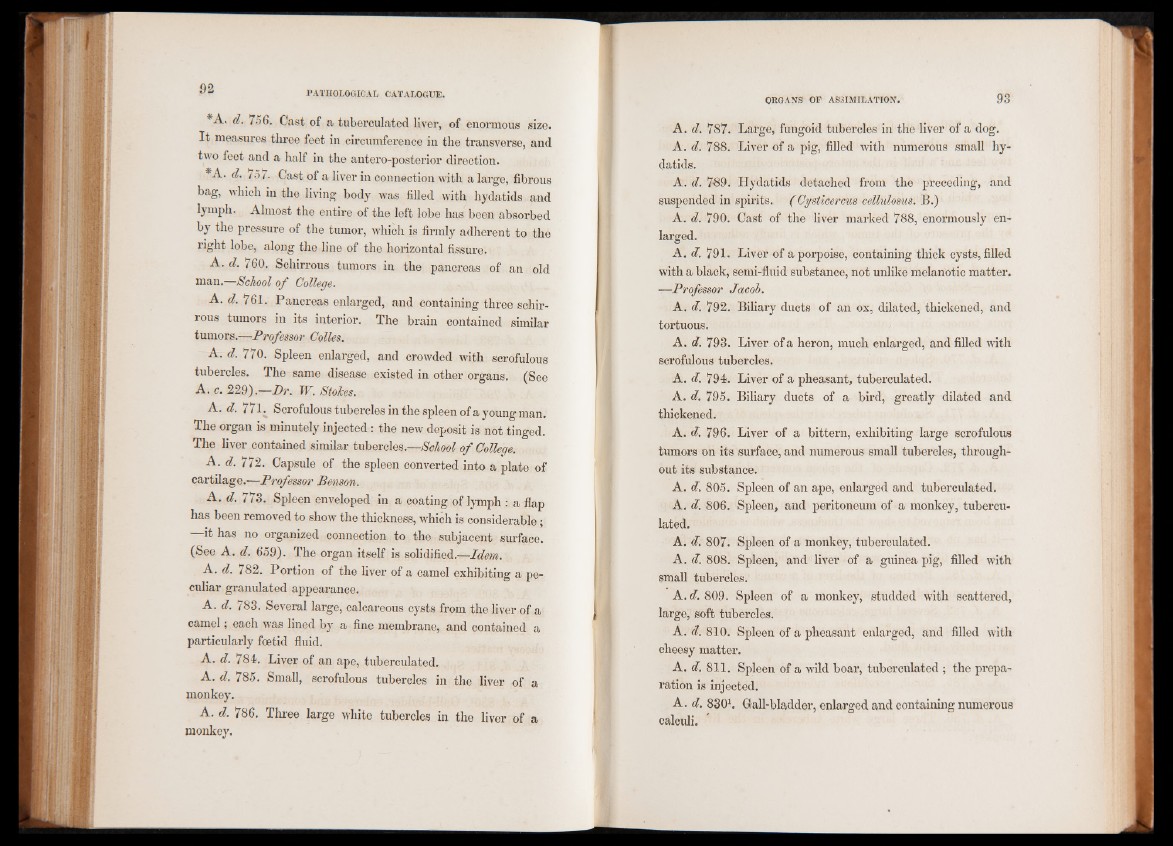
A. d. 756. Cast of a tuberculated liver, of enormous size.
It measures three feet in circumference in the transverse, and
two feet and a half in the antero-posterior direction.
*A. d. 75 7- Cast of a liver in connection with a large, fibrous
bag, which in the living body was filled with hydatids and
lymph. Almost the entire of the left lobe has been absorbed
by the pressure of the tumor, which is firmly adherent to the
right lobe, along the line of the horizontal fissure.
A. d. 760. Schirrous tumors in the pancreas of an old
man.—School of College.
A. d. 761. Pancreas enlarged, and containing three schirrous
tumors in its interior. The brain contained similar
tumors.—Professor Colies.
A. d. 770. Spleen enlarged, and crowded with scrofulous
tubercles. The same disease existed in other organs. (See
A. c. 229).—Dr. W. Stolces.
A. d. 77l; Scrofulous tubercles in the spleen of a young man.
The organ is minutely injected: the new deposit is not tinged.
The liver contained similar tubercles.—School of Colleqe.
A. d. 772. Capsule of the spleen converted into a plate of
cartilage.—Professor Benson.
A. d. 773. Spleen enveloped in a coating of lymph : a flap
has been removed to show the thickness, which is considerable;
—it has no organized connection to the subjacent surface.
(See A. d. 659). The organ itself is solidified.—Idem.
A. d. 782. Portion of the liver of a camel exhibiting a peculiar
granulated appearance.
A. d. 783. Several large, calcareous cysts from the liver of a
camel; each was lined by a fine membrane, and contained a
particularly foetid fluid.
A. d. 784. Liver of an ape, tuberculated.
A. d. 785. Small, scrofulous tubercles in the liver of a
monkey.
A. d. 786. Three large white tubercles in the liver of a
monkey.
A. d. 787. Large, fungoid tubercles in the liver of a dog.
A. d. 788. Liver of a pig, filled with numerous small hydatids.
A. d. 789. Hydatids detached from the preceding, and
suspended in spirits. ( Cysticercus cellulosus. B.)
A. d. 790. Oast of the liver marked 788, enormously enlarged.
A. d. 791. Liver of a porpoise, containing thick cysts, filled
with a black, semi-fluid substance, not unlike melanotic matter.
—Professor Jacob.
A. d. 792. Biliary ducts of an ox, dilated, thickened, and
tortuous.
A. d. 793. Liver of a heron, much enlarged, and filled with
scrofulous tubercles.
A. d. 794. Liver of a pheasant, tuberculated.
A. d. 795. Biliary ducts of a bird, greatly dilated and
thickened.
A. d. 796. Liver of a bittern, exhibiting large scrofulous
tumors on its surface, and numerous small tubercles, throughout
its substance.
A. d. 805. Spleen of an ape, enlarged and tuberculated.
A. d. 806. Spleen, and peritoneum of a monkey, tuberculated.
A. d. 807. Spleen of a monkey, tuberculated.
A. d. 808. Spleen, and liver of a guinea pig, filled with
small tubercles.
A. d. 809. Spleen of a monkey, studded with scattered,
large, soft tubercles.
A. d. 810. Spleen of a pheasant enlarged, and filled with
cheesy matter.
A. d. 811. Spleen of a wild boar, tuberculated ; the preparation
is injected.
A. d. 830b Gall-bladder, enlarged and containing numerous
calculi.